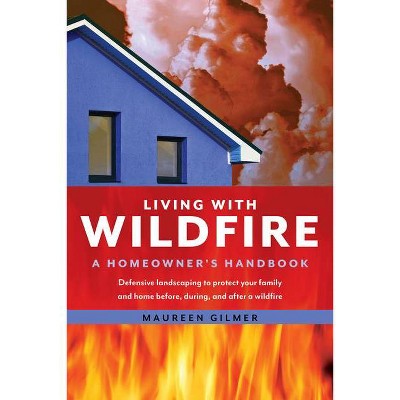Wildfire Loose - by Joyce Butler (Paperback)

Similar Products
Products of same category from the store
AllProduct info
<p/><br></br><p><b> About the Book </b></p></br></br>In October 1947, Maine experienced the worst fire disaster in its history. Wildfire Loose describes how the fires started and spread so quickly through rural villages, down Millionaire's Row in Bar Harbor, and across southern Maine beach resorts. Originally published in 1979, ...<p/><br></br><p><b> Book Synopsis </b></p></br></br>In October 1947, Maine experienced the worst fire disaster in its history. Climaxing months of drought, fires raged across more than 200,000 acres. Nine communities were practically leveled and four others severely damaged. Fifteen people lost their lives. Wildfire Loose describes how the fires started and spread so quickly through rural villages, down Millionaire's Row in Bar Harbor, and across southern Maine beach resorts. Originally published in 1979, it remains the definitive account of "The Week Maine Burned."<p/><br></br><p><b> Review Quotes </b></p></br></br><br>If it wasn't true, Wildfire Loose: The Week Maine Burned would make a good science fiction tale. I knew that Bar Harbor and Mt. Desert Island burned badly in 1947, but I did not know the devastating fires spread throughout the state, terrorizing Mainers, exhausting fire fighters, wiping out entire communities. Glad I wasn't born until 1948! A severe drought set the stage for this tragedy, which was ignited, in many places, by carelessly tossed cigarettes. Some of the fires were deliberately set. But it only took a single spark to set the ground ablaze. From the New Hampshire border to Washington County, Moosehead Lake to Harpswell, and even in the city of Portland, fires raged out of control. "In 35 communities," reports author Joyce Butler, "109 houses had been damaged, and 851 permanent homes, 397 summer homes, and an undetermined number of barns and garages had been destroyed." "Millions of trees were killed, millions severely burned." In York County, more than 131,000 acres, "80 percent of it woodland, were black." More than 200,000 acres statewide burned. And three million feet of cut lumber was destroyed. But it was the homes, farms, and businesses destroyed by these raging fires that were the most devastating losses. Everything their owners possessed, including pets, was lost. Butler excels in telling their individual stories. In this single October week, "nine communities had been practically wiped out, four more had suffered severe damage, and scores of others had lost buildings. Property damage was estimated at $30 million. Fifteen had died... In many sections the earth itself had been consumed. Maine had become an armed camp, her roads patrolled by the National Guard, Legionnaires, the police, and self-appointed vigilantes." Regular folks - including lots of high school and college students - mustered out all over the state to help fight the fires. It was particularly painful to read the accounts of Maine farmers who lost everything. Here's one. "At his farm on the hill above Route 5 (in Dayton), Roy Meserve watched until the sky began to show red over the edge of a hill about a half mile away. Then he ran to the stable for a tool kit he wanted to save and then to the barn to loose his horses and cattle. He had turned out twenty of the cows, most of them his nephew's, when he heard someone shout form the barnyard. "He ran to the door and had to drop to his hands and knees and crawl to safety. The barn was on fire. The sky was raining sparks. The animals he had not had time to loosen died in the flames, the flesh burned away from their bones. His house - everything he had worked for all his life - was gone." Many domestic animals died in the fires. And while lots of wild animals were able to flee the fire, many were killed. Rabbits ran down the roads with their fur on fire, described by firefighters as "little balls of flame rolling along the ground." "The morning after Lyman was swept by fire," writes Butler, "Route 111 was strewn with rabbits and other small animals, dead of asphyxiation... Dead trout were found in a North Kennebunkport brook... firefighters saw confused grouse flying into the fire." "Wardens found deer suffocated in fields where they had taken refuge. One deer, evidently fleeing the fire, running and leaping through the smoky woods, had impaled himself on a snag." And even the critters that escaped, "faced starvation in the long winter ahead for the fire hard destroyed their natural feed and cover. When hunting was allowed in November in order to lower the deer population, hunters found many of the deer they killed had severely burned feet." Five hundred members of fish and game and rod and gun clubs spent the first weekend of November looking for animals - dead or alive - in the fields and forests of York County. There are many heroes in this book. Some are pictured in a collection of photos in the center of the book. Joyce Butler has written eight books, including a two-volume history of the Kennebunks, curated several exhibits at the Center for Maine Histories, and lectured widely. Wildfire Loose was originally published in 1997, the 50th anniversary of the great fires of 1947, and reissued in 2014 by Down East Books, which also published the original. We are fortunate that Butler was able to interview some of the folks who were impacted by the fire. Their accounts are astonishing, and in many cases, heartbreaking. Butler said she didn't want us to ever forget this fire. If you read this book, you certainly won't. --George Smith, Bangor Daily News<br><p/><br></br><p><b> About the Author </b></p></br></br>Joyce Butler has written eight books, most recently a two-volume history of the Kennebunks. She has also written numerous articles for newspapers and magazines. A long-time resident of Kennebunk, Maine, she has been Town Historian since 1990.
Price History
Price Archive shows prices from various stores, lets you see history and find the cheapest. There is no actual sale on the website. For all support, inquiry and suggestion messagescommunication@pricearchive.us




















